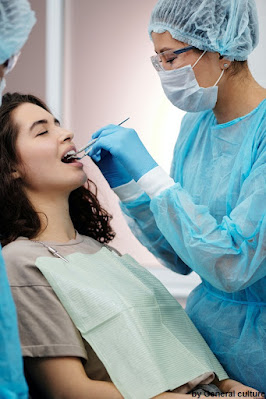Tooth decay is a situation wherein elements of the teeth decay, can also additionally regularly become small or massive holes.
Tooth decay is one of the maximum typical fitness issues in distinctive elements of the world, and it's far typical specifically amongst youngsters and adolescents, however, all and sundry can also additionally expand cavities of their mouth, and if teeth decay isn't treated, the holes can also additionally develop and develop and develop. It expands inflicting intense pain, infections, or even teeth loss and different complications.
A normal go to the dentist, cautious tooth cleansing, and the usage of dental floss for normal and everlasting dental cleansing is an exceptional manner to save you teeth decay and cavities.
:Tooth decay stages
early cavity in the mouth, like different organs withinside the body, carries many unique forms of germs, and a number of those germs develop and multiply in the surroundings of various meals or beverages that incorporate cooked sugars or starches, which might be additionally referred to as fermented carbohydrates.
When those carbohydrates aren't eliminated whilst brushing the tooth, germs convert them into acids within 20 minutes. The germs, acids or meals particles, and saliva grow to be a dental plaque, which is a sticky layer protecting the tooth.
When setting the tongue at the tooth, this dental plaque may be sensed just a few hours after brushing the tooth, and the dental plaque is fairly tough withinside the location of the tooth and molars, mainly alongside the gum line.
Tooth decay stages:
The following explains the most important stages of tooth decay:
1-The acids that shape in dental plaque assault the minerals withinside the tough layer of the teeth known as the tooth, which is the outer layer that covers the teeth. Erosion of the tooth layer withinside the teeth results in the prevalence of small holes in it and therefore teeth decay.
2-Parts of the teeth layer are eroded, and hence germs and acids can attain the second layer of the tooth, which is referred to as dentin, which is the center layer of the tooth. This layer is softer and much less capable of withstanding acids than the teeth layer.
3-When the teeth decay procedure reaches this point, the frequency and pace of teeth decay step by step increased, and as this continues, microorganisms and acids development in their manner to the layers that make up the teeth, in which they develop to the pulp layer, that is the internal layer of the teeth, which ends up in swelling and irritation.
4-pregnancy tooth decay additionally impacts the bones that assist the teeth. In very superior tiers of care, the affected person reports excessive pain, immoderate sensitivity of the tooth whilst biting, and different symptoms.
5-The frame might also additionally protect in opposition to such bacterial penetration internal with the aid of using sending white blood cells to combat the rising infection, due to which an abscess might also additionally shape withinside the tooth because the teeth decay procedure takes a quick time
Types of caries:
The dentist determines the types of caries, which are three as follows:
1. Dental caries on the tooth surface
This kind impacts the outer floor of the tooth, in which germs can live for an extended time, at the same time as acids assault the tooth layer. It frequently seems at the outer aspect of the tooth, i.e. toward the cheek withinside the line near the gum, and this kind may be avoided and dealt with without problems until it seems withinside the regions among the teeth.
2. Tooth decay of molar teeth
Tooth decay of this kind assaults the gaps and concavities withinside the grinding tooth at the floor of the chewing part, and this kind might also additionally expand swiftly if we do now no longer care approximately oral and dental hygiene, or if we do now no longer deal with teeth decay at once whilst it appears.
3. Dental caries from the root of the tooth
Tooth decay of this kind seems withinside the location of the foundation of the teeth and is particularly convenient in folks that be afflicted by receding gums.
dental decay symptoms:
The preliminary signs and symptoms of the improvement of dental caries vary from one case to another, and they're associated with the diploma of caries and their location. Caries in its starting won't be followed through any signs and symptoms or signs, however extra caries intensifies, special signs and symptoms might also additionally appear, inclusive of the following:
- toothache.
- Tooth sensitivity.
- Slight or sharp pain when eating hot or cold foods or sweetened drinks.
- Dental holes that can be seen with the eye.
- Pain when biting into food.
- The appearance of pus around the tooth.
Causes and risk factors for dental caries:
Below is an explanation of the causes, risk factors and how tooth decay occurs
1. Causes of tooth decay
The causes and factors that increase caries include the following:
- Not taking care of dental hygiene
- Have sweets and snacks on sugary dri
2. Risk factors for tooth decay
dental decay is one of the maximum widely widespread fitness troubles withinside the world, and there are numerous elements that growth the chance of growing caries or the improvement of a case of teeth decay, which encompass the following:
- Unclean Teeth: Not brushing the teeth.
- Mineral water: adding fluoride to drinking water helps reduce the spread of caries among people; Because these minerals protect the enamel layer of the tooth, but nowadays many people consume mineral water or filtered water that does not contain fluoride, thus losing the protection that fluoride provides to their teeth.
- Age: Older adults' teeth are more susceptible to decay.
- Dental problems: teeth complaining of gingival retraction.
- Dehydration in the oral cavity: Dehydration in the oral cavity indicates a lack of saliva,
- and saliva plays a central role in preventing untreated tooth decay , as it rinses food residues and dental plaques from the teeth, and the minerals in it help treat the early stages of tooth decay.
- Feeding disorders: Deliberate anorexia or bulimia may lead to serious erosion of the layers of the tooth and the emergence of caries. Digestive acids that reach the oral cavity as a result of vomiting affect the teeth and lead to the erosion of the enamel layer in them, and feeding disorders may confuse and impede the production of saliva.
- Heartburn: Heartburn increases the risk of tooth decay.
- Close contact: Some germs that cause tooth decay can be transmitted from one person to another through kissing or the use of shared eating utensils, and parents or people who are very close to children may transmit these germs to them.
- Cancer: Some cancer treatments.
Tooth decay complications:
Tooth decay is so widespread that many people do not take it seriously. For example, it is common to not pay attention to children’s infection with caries in brown teeth, but tooth decay may lead to serious and long-term complications and complications, even in children whose teeth have not sprouted fixed after
Among these complications are:
- Aches.
- Abscess in the teeth.
- Tooth loss.
- Teeth fracture.
- Chewing problems.
- Severe infections.
When tooth decay reaches a stage where the aches are very severe, this may hinder the normal practice of daily life to the point of preventing the student from going to school or the worker to work, but if the aches are severe and hinder the process of eating or chewing, it may lead to malnutrition and then Weight loss.
If cavities lead to tooth loss, this may negatively affect self-confidence, and in some very rare cases, an abscess formed as a result of tooth decay may lead to severe infection that may pose a threat to the patient's life if not treated properly.
Dental caries diagnosis:
The dentist can diagnose tooth decay very easily. He asks you if you have pain or sensitivity, then examines your mouth and teeth, and pricks the teeth with a special examination tool to check whether there are loose places in the teeth.
You may need dental x-rays, which are also able to diagnose cavities.
Tooth decay treatment:
Dental caries treatment is largely related to the degree of caries, its severity, and the health status in general. Among the treatments it includes:
- Fluoride therapy.
- Composite fillings.
- Dental nerve treatment.
- The placement of a complete tooth covering is used to restore and repair damaged teeth.
- age dislocation.
Tooth decay prevention:
Maintaining regular oral and dental hygiene helps prevent tooth decay. If you follow the following tips and instructions, you can prevent tooth decay or rot, which includes the following:
- Brushing your teeth after eating or drinking.
- mouth rinse.
- Visit a dentist regularly.
- Examine the possibility of tightening the gaps between the teeth.
- Drink water from the faucets if it is guaranteed to be free of germs and microbes.
- Refrain as much as possible from eating snacks and sweetened drinks.
- Eat foods that promote dental health.
- Fluoride treatment.
- Use antibacterials when necessary and after consulting a doctor.
Alternative therapies:
Herbs do not cure dental caries, but they may help relieve tooth decay pain, including the following:
- ginger.
- thyme.
- turmeric.
- Yarrow herb.
- mint.
- Chamomile.
- the Garlic.
- carnations.









0 Comments